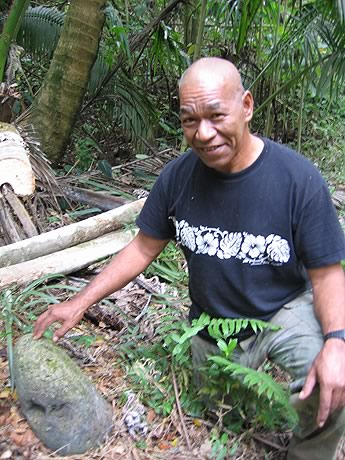 Early morning in the Puna District on the rainy side of the Big Island. A sputtering car engine idles in the driveway, competing with the stereophonic coqui frog sing-along and awaking bird choir. My long-time friend Willy Iaukea is grinning from the driver’s window and cajoles, “Come on! It’s time for an adventure.”
Early morning in the Puna District on the rainy side of the Big Island. A sputtering car engine idles in the driveway, competing with the stereophonic coqui frog sing-along and awaking bird choir. My long-time friend Willy Iaukea is grinning from the driver’s window and cajoles, “Come on! It’s time for an adventure.”
He does this often. A truck honk will announce his unexpected arrival, followed by that infectious smile and an invitation to join him on an expedition to some remote part of the island. He knows where the petroglyphs are carved, where the leatherback turtles come to lay their eggs, the terrain that hides lava tube caves with ancient skulls staring back at us along its ledges. He knows the dark, secretive places where the ali’i, or royalty, hid during the many tribal wars. I never know where we are headed or when I will return to my home, but I’ve learned that to not take him up on his offer and hop in his truck for a day of exploration is a day sadly spent. He is my Hawaiian history guide. So what if all that day I have to live on Spam musubi—a questionable delicacy composed of a block of rice with a slice of grilled Spam on top and nori (seaweed) wrapping to hold it together. It is sold in every gas station and mom & pop grocery store on the island.
So away we go.
Willy loves his hot coffee, his Spam, his cigarettes, and long drives punctuated with “talk story.” He is the real deal, a career military guy with deep Hawaiian roots. Willy is from the original stock of navigators and astronomers who arrived in Hawai’i sometime between A.D. 300 and 800 in canoes from Polynesia. Hence he knows everybody on the island, as he is probably related to them in one way or another.
Two hours later, his rusty, reliable truck carries us over the windswept shoulders of Kohala Volcano. We are on a journey to the other side of the Big Island to visit Willy’s ancestors. After stopping in Hawi for coffee, we turn onto a rutted dirt road and jounce along for miles on a ribbon of bucking bronco road sloping toward the sea. The track ends abruptly at a barbed-wire fence. Willy pulls his weed whacker out of the truck bed and, in response to my puzzled look, says, “My relatives are buried here. I come every so often to clear the weeds.”
I walk to the cliff’s edge through cane grass gone wild, like a lion’s mane blanketing the hills all the way down to the bluff that drops into the fathomless ‘Alenuihaha Channel that separates Maui from the Big Island. It is a warm, blue day. I sit, hypnotized by the swirling surf below. Finally, Willy joins me and unwinds the story of this isolated, windswept place.
“There was a healing heiau [temple] here in the 1700s. Chieftess Keku’iapoiwa, King Kamehameha’s mother, was the head kapuna [priestess]. Warriors returned, wounded from battle—not just physically, but from what we today call PTSD. They were sent here to mend those inner traumas. The kapuna prescribed that they sit right here and stare for days into the ocean where that rock protrudes.”
“Why?” I ask. I can’t imagine sitting here interminably without hats and sunglasses, but keep myself from saying so. I’ve learned not to interrupt Willy’s storytelling with irreverent witticisms.
“They were not told why,” Willy says, “But look at the rock. That place where the rock is located creates a unique phenomenon. Three powerful, surging currents come together. When the tide is right, they clash like titans and spray upward, creating an upside down waterfall or a geyser. The warriors were told to gaze unrelentingly at this, letting the force and imagery pull the shards of painful memory from their minds, releasing them to the sky. It could take weeks.”
“Why are your relatives buried here?” I ask.
Willy leads me to the two graves he has cleared just a few feet from the cliff’s edge. “My uncles’ role was to protect the ali’i. One night a chief from Maui sent his men in secret under the cover of night to attack this temple, knowing that King Kamehameha was waiting for them on the battlegrounds at South Point on the other side of the island. King Kamehameha’s troops were tricked into leaving their post by this chief, who attacked the heiau. Everyone was killed. My uncles died defending Keku’iapoiwa.”
We kneel over the burial mounds. There is a crack between the stones in one of the graves. I spontaneously take off my dangly blue earring and drop it in, a gift. We peer into the crevice and stare at the glinting sapphire catching a ray of sun.
“It looks like a whale’s eye,” I say.
The silence around us is suddenly filled with an enormous whoosh, a cool mist of saltwater spray and an exhale. A wind of breath. We look down at the water, where only twenty feet away two huge humpback whales have breached so high they are looking at us eye-to-eye.
![]()
Photo of Willy Iaukea taken by Lisa Alpine. The Blue Eye has been published in BATW’s Travel Stories From Around the Globe and Exotic Life: Travel Tales of an Adventurous Woman.
Find out about our Off-Grid Living Big Island Style in Hawaii Business Magazine. For another fun story about the Big Island, read Loving the Lava and discover the best breakfast at Paul’s Cafe in Hilo.
Leave a Reply